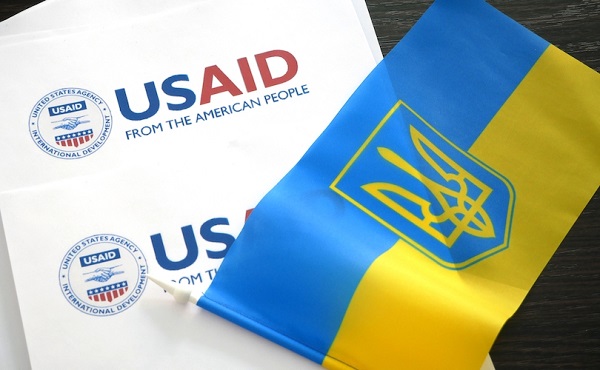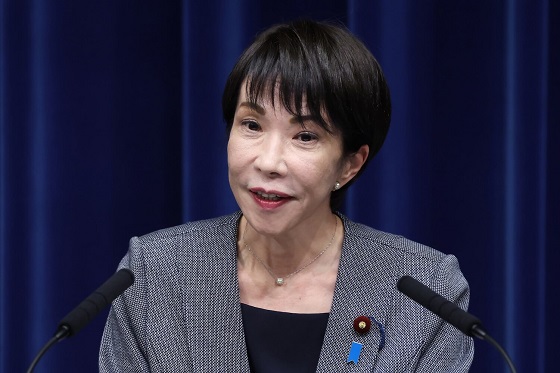Business
90% of Ukraine news outlets get funding from USAID: new report

From LifeSiteNews
By Matt Lamb
USAID, targeted by Elon Musk and Donald Trump for cuts, is a heavy funder of news outlets in Ukraine, according to a new report. The agency has come under scrutiny for wasteful and ideological projects.
The United States Aid for International Development (USAID) provides funds to 90 percent of Ukrainian news outlets, according to a new report from the Columbia Journalism Review and Reporters Without Borders.
While much focus has been on USAID and other federal entities subscribing to news outlets such as Politico, a broader issue may be taxpayers paying for news coverage in foreign countries.
Working off data from Reporters Without Borders, the Columbia Journalism Review reported that “USAID had boasted of supporting more than six thousand journalists, around seven hundred independent newsrooms, and nearly three hundred media-focused civil society groups in thirty or so countries.”
The Trump administration reportedly froze $268 million for these endeavors.
“RSF also noted the harsh effect on journalism in Ukraine, where 90 percent of news organizations rely on USAID funding, some very heavily,” the Journalism Review reported.
The United States has spent nearly $66 billion on direct military assistance to Ukraine in its ongoing war against Russia. Taxpayers have sent another $120 billion or so to the country in other foreign aid, according to an inspector general report current as of September 30, 2024.
The journalism groups released the reports ostensibly to defend U.S. funding of outlets.
On a related issue, the Trump administration is also cutting off taxpayer-funded subscriptions that government employees set up with news outlets.
“I can confirm that the more than $8 million taxpayer dollars that have gone to essentially subsidizing subscriptions to Politico on the American taxpayers’ dime will no longer be happening,” White House Press Secretary Karoline Leavitt said during a press conference yesterday.
Politico itself had not received $8 million in subscriptions, but the press secretary, who said she learned of the issue right before the briefing, was referring to outlets in general.
“The DOGE team is working on canceling those payments now,” she said.
She stated further:
Again, this is a whole-of-government effort to ensure that we are going line by line when it comes to the federal government’s books. And this president and his team are making decisions across the board on ‘Do these receipts serve the interests of the American people? Is this a good use of the American taxpayers’ money? If it is not, that funding will no longer be sent abroad and American taxpayers will be seeing significant savings because of that effort.
Conservatives celebrated the news.
“The Federal Government is not a good steward of your tax dollars,” Josh Tanner, an Idaho state representative, wrote on X. “They spent $8 Million on propaganda media. This is even more of a reason for Idaho tax dollars to be accounted for, applied appropriately, and reduced where necessary. The Fed has failed, our state must succeed.”
“Even if the govt money to Politico wasn’t an outright grant, providing $8 Million in taxpayers funds for ‘subscriptions’ to a super Lefty publication is just absurd and abusive to hard-working Americans!” conservative commentator Steve Cortes wrote.
A payroll issue with Politico‘s payroll was initially blamed on the funding freeze, though the company said it was a “technical error” that created the problem.
USAID under scrutiny, uses tax dollars to promote DEI around the world
The Trump administration has closed, at least temporarily, USAID. Secretary of State Marco Rubio is now the administrator of the agency, which has funded a variety of ideological projects across the globe.
“USAID has a history of ignoring [the national interest of the United States] and deciding that they’re a global charity. These are not donor dollars, these are taxpayer dollars,” Secretary Rubio said recently.
Leavitt highlighted some of the ideological and wasteful projects funded through this agency, including “$1.5 million to advance DEI in Serbia’s workforce.”
The agency has also been used to pressure conservative, poorer countries into adopting pro-abortion policies, as LifeSiteNews previously reported.
State Department spokeswoman Tammy Bruce highlighted other wasteful projects in a post on X.
She listed projects the freeze had stopped, including “$16 million in unjustified funding for institutional contractors in the gender development offices,” “$4 million to unjustified funding for the Center for Climate-Positive Development,” and “$600,000 to fund technical assistance for family planning in Latin America.”
Business
Stripped and shipped: Patel pushes denaturalization, deportation in Minnesota fraud

FBI Director Kash Patel issued a blunt warning over the weekend as federal investigators continue unraveling a sprawling fraud operation centered in Minnesota, saying the hundreds of millions already uncovered represent “just the tip of a very large iceberg.”
In a lengthy statement posted to social media, Patel said the Federal Bureau of Investigation had quietly surged agents and investigative resources into the state well before the scandal gained traction online. That effort, he said, led to the takedown of an estimated $250 million fraud scheme that stole federal food aid intended for vulnerable children during the COVID pandemic.
According to Patel, the investigation exposed a network of sham vendors, shell companies, and large-scale money laundering operations tied to the Feeding Our Future case. Defendants named by the FBI include Abdiwahab Ahmed Mohamud, Ahmed Ali, Hussein Farah, Abdullahe Nur Jesow, Asha Farhan Hassan, Ousman Camara, and Abdirashid Bixi Dool, each charged with offenses ranging from wire fraud to conspiracy and money laundering.
Patel also said Abdimajid Mohamed Nur and others were charged in a separate attempt to bribe a juror with $120,000 in cash. He noted that several related cases have already resulted in guilty pleas, prison sentences of up to 10 years, and nearly $48 million in restitution orders.
Despite those outcomes, Patel warned the case is far from finished.
“The FBI believes this is just the tip of a very large iceberg,” he said, adding that investigators will continue following the money and that the probe remains ongoing. Patel further confirmed that many of those convicted are being referred to immigration authorities for possible denaturalization and deportation proceedings where legally applicable.
The renewed focus follows a viral video circulated by independent journalist Nick Shirley, which appeared to show multiple childcare and learning centers operating as empty or nonfunctional storefronts. The footage sparked immediate backlash from Republicans, including Vice President JD Vance.
House Majority Whip Tom Emmer accused Minnesota Gov. Tim Walz of sitting idle while massive sums were stolen from taxpayers. Walz addressed the allegations during a November press conference, before the full scope of the fraud became public, saying the scandal “undermines trust in government” and threatens programs meant to help vulnerable residents.
“If you’re committing fraud, no matter where you come from or what you believe, you are going to go to jail,” Walz said at the time.
Authorities say the alleged schemes date back to at least 2015, beginning with overbilling Minnesota’s Child Care Assistance Program and later expanding into Medicaid-funded disability and housing programs. One such housing initiative, aimed at helping seniors and disabled residents secure stable housing, was shut down earlier this year after officials cited what they described as large-scale fraud.
The fallout has already reached the federal level. Last month, President Trump announced the suspension of Temporary Protected Status for Somali nationals, arguing that Minnesota had become a hub for organized welfare fraud and money laundering activity.
Business
Mainstream media missing in action as YouTuber blows lid off massive taxpayer fraud

Vice President JD Vance is giving public credit to a YouTube journalist for doing what he says legacy media and elite institutions have failed to do: follow the money in Minnesota. In a post on X, Vance praised independent reporter Nick Shirley for digging into alleged fraud networks tied to the state, saying Shirley “has done far more useful journalism than any of the winners of the 2024 Pulitzer prizes.” The comment was a direct response to a video Shirley shared online documenting what he described as widespread fraud, with Shirley claiming his team identified more than $110 million in suspicious activity in a single day while confronting facilities allegedly receiving millions in public funds.
Shirley’s reporting has been circulating widely among conservatives, with commentators amplifying clips of him visiting supposed daycare and education centers that appeared inactive despite receiving massive federal aid. Conservative media personality Benny Johnson said Shirley had exposed more than $100 million in Minnesota Somali-linked fraud routed through fake daycare and healthcare fronts, adding to the pressure on state leadership. The issue gained further traction after Tom Emmer, Minnesota’s top House Republican, demanded answers from Gov. Tim Walz following a viral clip showing Shirley confronting workers at an alleged daycare in South Minneapolis. Shirley reported the center, called the “Quality Learning Center,” showed no visible activity despite claims it served up to 99 children, and even misspelled “learning” on its signage. As Shirley approached, a woman inside was heard shouting “Don’t open up,” while incorrectly accusing him of being an ICE agent.
🚨 Here is the full 42 minutes of my crew and I exposing Minnesota fraud, this might be my most important work yet. We uncovered over $110,000,000 in ONE day. Like it and share it around like wildfire! Its time to hold these corrupt politicians and fraudsters accountable
We ALL… pic.twitter.com/E3Penx2o7a
— Nick shirley (@nickshirleyy) December 26, 2025
The controversy builds on earlier reporting from City Journal, which published a November investigation citing federal counterterrorism sources who said millions of dollars siphoned through Minnesota fraud schemes had been sent overseas, with some of the money allegedly ending up in the hands of Al-Shabaab. One confidential source quoted in the report bluntly claimed, “The largest funder of Al-Shabaab is the Minnesota taxpayer.” Since that report, the scrutiny has widened inside the Trump administration. Treasury Secretary Scott Bessent has announced that the Treasury Department is examining whether Minnesota taxpayer funds were diverted to terrorist-linked groups, while Education Secretary Linda McMahon has publicly called on Walz to resign amid separate allegations of large-scale education fraud within the state’s college system.
Taken together, the attention from Vance, congressional Republicans, and multiple federal agencies has elevated Shirley’s reporting from viral internet content to a flashpoint in a broader debate over fraud, accountability, and the role of independent journalists. For the vice president, the message was clear: real accountability sometimes comes not from prize committees or press rooms, but from outsiders willing to ask uncomfortable questions and stand in front of locked doors with a camera rolling.
-

 Business2 days ago
Business2 days agoLargest fraud in US history? Independent Journalist visits numerous daycare centres with no children, revealing massive scam
-

 Business2 days ago
Business2 days ago“Magnitude cannot be overstated”: Minnesota aid scam may reach $9 billion
-

 Business5 hours ago
Business5 hours agoLand use will be British Columbia’s biggest issue in 2026
-

 Business17 hours ago
Business17 hours agoWhat Do Loyalty Rewards Programs Cost Us?
-

 Censorship Industrial Complex2 days ago
Censorship Industrial Complex2 days agoUS Under Secretary of State Slams UK and EU Over Online Speech Regulation, Announces Release of Files on Past Censorship Efforts
-

 Haultain Research18 hours ago
Haultain Research18 hours agoSweden Fixed What Canada Won’t Even Name
-

 Energy6 hours ago
Energy6 hours agoWhy Japan wants Western Canadian LNG
-

 Business3 hours ago
Business3 hours agoMainstream media missing in action as YouTuber blows lid off massive taxpayer fraud


